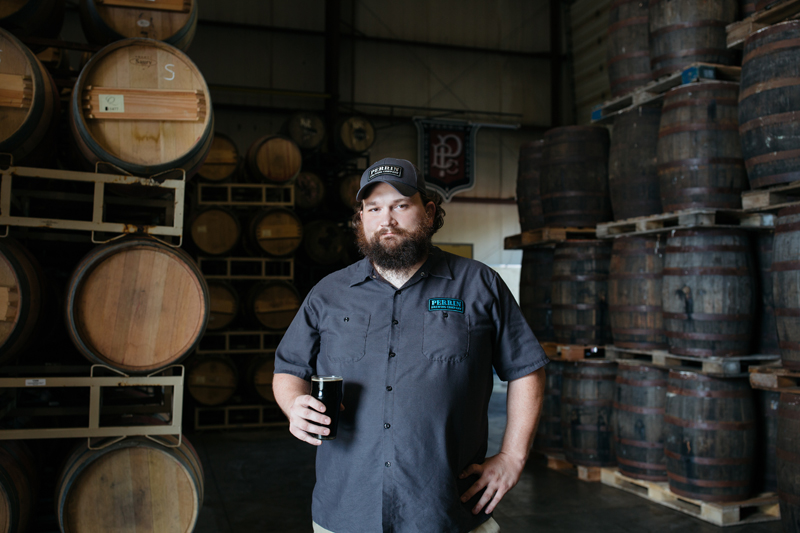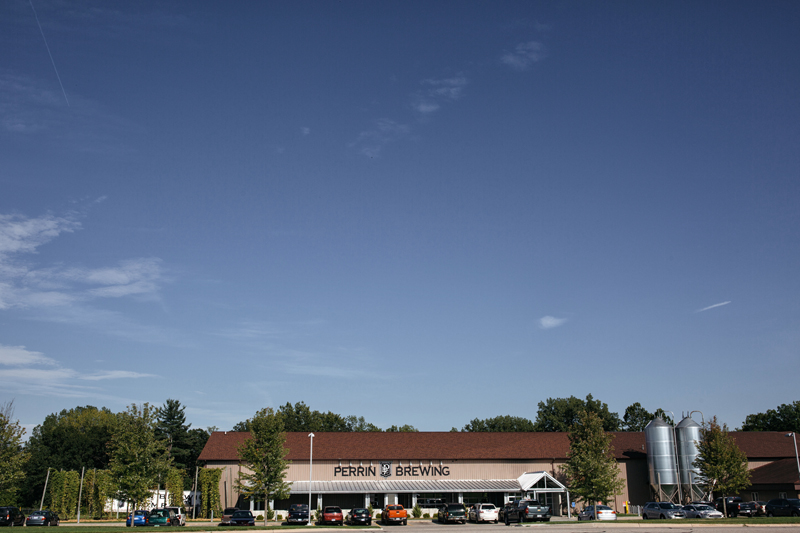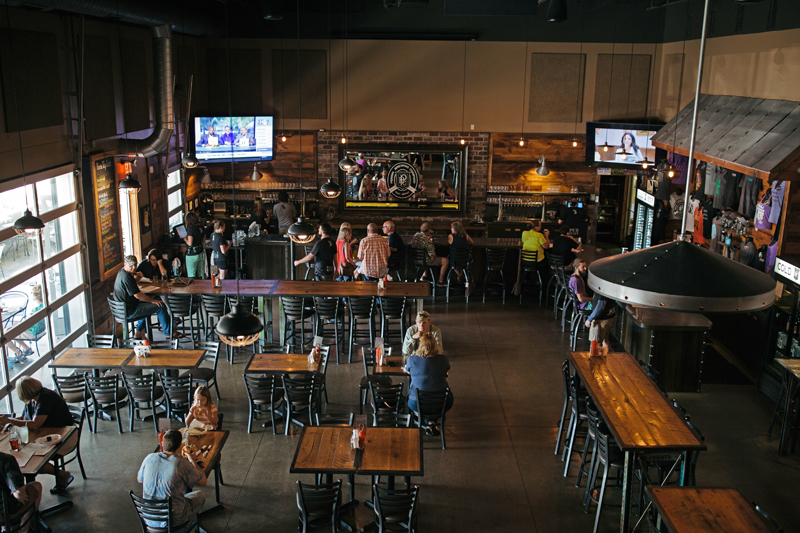Pull Up A Stool With John Stewart
of Perrin Brewing Co.

John Stewart of Perrin Brewing Co. (Photo by Nathan Teft/Arielle Teft Photography)
Editor’s Note: This story appears in the November 2016 issue of All About Beer Magazine. Click here to subscribe.
Since the start of his brewing career nearly a dozen years ago, John Stewart has been lucky to work with barrels. From New Holland Brewing Co., where he was responsible for barrel aging Dragon’s Milk, to Saugatuck Brewing Co., where he launched a wood program. Now at Perrin Brewing Co., where he works as director of brewing operations, Stewart has learned from the wood and is eager to share his knowledge.
All About Beer: What do you think is the biggest misconception about barrel aging?
John Stewart: You can’t work with deadlines and dates. The beer is ready when it tells me it’s ready. We can ballpark it from previous experience, but it’s about putting the beer in the best environment and keeping it as consistent as we can to get the beer to the peak point. It can’t be too short or too long; it’s gotta be the right window. That’s why when I hear of places just putting a beer in for over a year or a year and a half because that sounds like a good time from a sales pitch perspective, and I just wonder why they would do that to the beer.
So how do you know when a beer is ready?
Usually, specifically with a high-alcohol barrel-aged beer, I’m looking to take out some of the alcohol warmth, to smooth out the sharp corners and to let the flavor profiles meld together. It should be layered and complex without sharp notes. So it depends on the barrel and the beer. We might only get that with a second- or third-use barrel, and we’re sitting around, waiting, tasting and waiting for the spirit to come through. With sour beers it’s letting the microorganisms do their thing. If you have [Pediococcus] in a beer, you’re just waiting for the Brettanomyces to kick in and chew up the diacetyl produced from the Pedio. As the Belgian brewers say, it’s gotta get sick before it gets better and moving in the right direction. So there’s always a lot of anticipation and loss of sleep worrying about these beers and great joy when they start turning and tasting the way you want.
Patience seems to be key.
It’s like a domesticated animal versus nondomesticated. You whistle and a dog will come, sit and shake. A cat will ignore you. The more you try to control it, the more they run away from you. When I’m in the brew house, I like to know what sour bacteria I’m pitching. I love to control pitch amounts, pH level and total acidity, but at some point I need to let go. It’s like beekeeping, I grew up with bees, and we would tell people you take the hive, give them the best environment and they do the magic. It’s a lot like that with sour beers. I do the best I can, get the right temperature, humidity, barrel purge and then wait back and hold my breath that it doesn’t go acetic. You’re waiting, and sometimes you’re wonderfully surprised and other times it’s taken a hard left turn. Then you have to dump.

(Photo by Nathan Teft/Arielle Teft Photography)
What misconception of barrel-aged beers would you like to change?
There’s so much availability of bourbon barrels and stouts and that’s where “wood-aged” immediately goes in people’s minds: A big 13% Russian Imperial Stout that goes down like a shot of whiskey. We try to break the mold a little bit. We have a 6.8% “session barrel-aged beer” where you can have a full pint because it’s on the lighter side. Or how people say don’t put hoppy beers in barrels because it imparts too much bitterness. But if you brew in a certain way, like an IPA without late addition or whirlpooling, you can get better results. We do one in tequila barrels like that, and the pine of the IPA really comes through and is a great complement to the barrel character. There is constant growth and learning with barrels. We have to learn and relearn, because it’s an evolving game.
There’s a lot of attention paid to bourbon barrels, but what do you see as the next frontier?
Oak alternatives. There’s maple spirals and birch and other things that can impart unique flavors that go beyond the vanilla and coconut that we find in American oak. There are coopers working with a wide range of woods these days. I recently had a porter aged in sassafras, and it imparted this wonderful pistachio nut flavor from the wood. That was pretty cool. There is so much wood you can play around with in a lifetime and not get bored.
–This interview was conducted and edited by John Holl, editor of All About Beer Magazine.

(Photo by Nathan Teft/Arielle Teft Photography)
John Stewart: At A Glance
Director of Brewing Operations, Perrin Brewing Company
Years in Brewing Industry: 12
Go-to beer from another brewery: Brooklyn Brewery Properly Lagered
Beer that inspired him early in life: German Oktoberfest beers
Couldn’t live without: My pitbull
Favorite place to have a beer:
Surrounded by loved ones around a cool Michigan summer night bonfire
Wishes he could buy a round for: My dad
Biggest passion besides brewing: Teaching and cage fighting. Some days one more than the other.
Keeping him up at night: Did I turn the CO2 off on that bright tank?
Company Profile
Perrin Brewing Co.
Comstock Park, Michigan
perrinbrewing.com
Founded: 2012
Annual Production: 24,000 barrels
Availability: Colorado, Indiana,
Michigan and Ohio
John Holl
John is the editor of All About Beer Magazine and the author of three books, including The American Craft Beer Cookbook. Find him on Twitter @John_Holl.

Hello, my name is Frederico de Castro (Fred). I am a student of beer tecnology, from Brazil, and I am trying to get some tips and information about beer blending and barrel aging beers. This article was very cool, thank you. I wonder if you could give me some more material, tips and other information I that I could use to learn even more, because I am ruming with a lack of information about this issue, and I am very interesting on it.
Thank you.